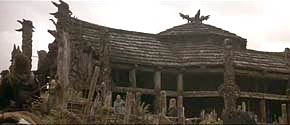Summary:
In this retelling of the epic Beowulf, a chosen band of viking warriors and their 13th companion, Ahmed Ibn Fahdlan (Antonio Banderas), travel to the aid of king Hrothgar whose land is under attack by an ancient evil. Lead by Buliwyf, this band sets out to destroy this evil that will become known as the Wendol, a group monsters who eat the dead. Through several battles and loss of men, the group hunt down the Mother of the Wendol and Buliwyf faces her alone in a match to the death. During this battle he is poisoned but he must kill the leader of the Wendol warriors before the rest of them will flee. In one last battle, the remaining warriors fight with the Wendol and Buliwyf kills the leader and the rest of them break and flee. Hrothgar's kingdom is saved and Ahmed Ibn Fahdlan begins his return back to his home country.
What are Some of the Medieval Elements?
One of the biggest elements that poses as the plot for this movie is the quest. A messenger arrives from Hrothgar's kingdom and then a seer is called upon to determine how many men should go and some the characteristics they should possesses such as the case of Ahemd who is chosen because the 13th warrior cannot be a Norse man. Here is the scene where all the warrior are chosen. Herger, the blond man that sits at the table with Ahmed is translating from Norse to Greek so that the older gentleman can translate it into Arabic so that Ahmed may understand what is being said.
The warrior band (in order of being chosen in the scene above):
Then we have a Hrothgar's kingdom and the monsters that hold it hostage. The village itself is made of logs and thatch roofs. King Hrothgar's hall, although not your picturesque castle, stands as the biggest building and demonstrates the power and wealth that his kingdom had before the Wendol began their attacks. The Wendol themselves can be seen as any type of threat against any medieval kingdom, whether that be another kingdom, a dragon or wizard. They also have their own type of wyrm or dragon. It is created out of the many men in their ranks snaking along a path and holding torches. This give the illusion to what the people of Hrothgar's kingdom call the "fire wyrm".
Then of course comes the weaponry and armor which varies greatly from warrior to warrior. There are the broad swords and round shields normally found in viking culture. There is also the use of bow and arrows as well as spears. The armor varies from chain mail to leather and some plated armor. This random assortment may seem strange but it fits with the history of viking raids and the taking of treasure and other goods from other country's.
 |
| Not a single warrior has the same type of armor. |
There are two women that can be seen as seer's in this movie. The first women divines who must travel north to help King Hrothgar in his time of need. She can be seen in the movie clip above. The second seer helps the warrior's determine how to defeat the Wendol and where they might be able to find where they live. She is the one that tells them to kill the mother of the Wendol and that Buliwyf must also beware the leader of their warriors, for he too must be killed or the Wendol will keep coming back.
 |
| The leader |
 |
| The mother |
One of my favorites scenes in this movie is not entirely based in it's medieval aspect but more of how it was skillfully done. As you may have noticed in the movie clip above, there are several languages being spoken. As the viewer, you get to hear what languages Ahmed hears which are foreign to him. This makes it hard for him to integrate into the group. As he travels with them and starts to immerse himself into the language he begins to understand it and the viewer begins to hear snippets of English until he fully understands the Norse language.
To go along with the different language barrier there is also the difference in religions. There is the Norse religion that is polytheistic and the Muslim religion that is monotheistic. Neither side truly tries to convince the other that one religion is better but Ahmed adopts the viking warriors mantra that they say before they go into battle or before they may be about to die. He also prayed to Muhammad before the last battle and answered mantra that his friends have full belief in.
Overall, the 13th Warrior has many elements that one would associate with a medieval movie. Although it might not immediately be what one thinks about when they think medieval, it puts forth a view different from the traditional Arthurian legend that most people think of when they hear the word medieval. I highly recommend watching this movie if you would like to see another take on the tale of Beowulf or read the book "Eaters of the Dead" by Michael Crichton.
All images found using Google search.






Very nice elaboration on the film!
ReplyDeleteI really enjoyed that you took the time to acknowledge the language barrier, despite it not necessarily being a "medieval" aspect. I remember hearing the Norse language for the first time and trying to translate or even just trying to decipher a little bit of it was one of the craziest experiences. Although a bit difficult, I've always found it really interesting to consider the language differences from time to time because it really shows how much cultural progression we've made.
Well done!